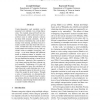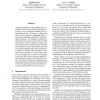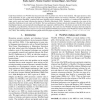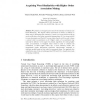EMNLP
2011
13 years 3 months ago
2011
Context-dependent word similarity can be measured over multiple cross-cutting dimensions. For example, lung and breath are similar thematically, while authoritative and superfici...
FLAIRS
2011
13 years 7 months ago
2011
This study presents an evaluation of WordNet-based semantic similarity and relatedness measures in tasks focused on concept similarity. Assuming similarity as distinct from relate...
ICASSP
2011
IEEE
13 years 7 months ago
2011
IEEE
Distributed representations of words are attractive since they provide a means for measuring word similarity. However, most approaches to learning distributed representations are ...
EMNLP
2010
14 years 1 months ago
2010
The computation of meaning similarity as operationalized by vector-based models has found widespread use in many tasks ranging from the acquisition of synonyms and paraphrases to ...
ACL
2010
14 years 1 months ago
2010
Existing word similarity measures are not robust to data sparseness since they rely only on the point estimation of words' context profiles obtained from a limited amount of ...
NAACL
2003
14 years 4 months ago
2003
Statistical measures of word similarity have application in many areas of natural language processing, such as language modeling and information retrieval. We report a comparative...
LREC
2010
14 years 5 months ago
2010
Graph-based similarity over WordNet has been previously shown to perform very well on word similarity. This paper presents a study of the performance of such a graph-based algorit...
ACL
2007
14 years 5 months ago
2007
The ability to detect similarity in conjunct heads is potentially a useful tool in helping to disambiguate coordination structures - a difficult task for parsers. We propose a di...
IJCNLP
2005
Springer
14 years 9 months ago
2005
Springer
Research on linear text segmentation has been an on-going focus in NLP for the last decade, and it has great potential for a wide range of applications such as document summarizati...
ICCBR
2007
Springer
14 years 9 months ago
2007
Springer
We present a novel approach to mine word similarity in Textual Case Based Reasoning. We exploit indirect associations of words, in addition to direct ones for estimating their simi...







